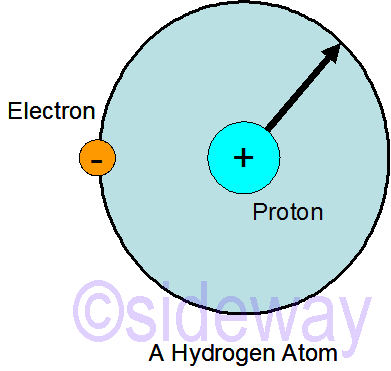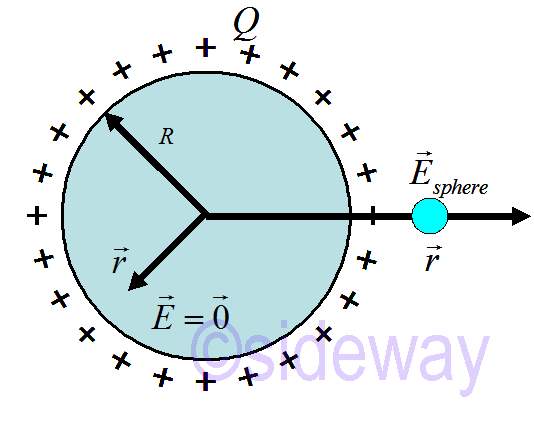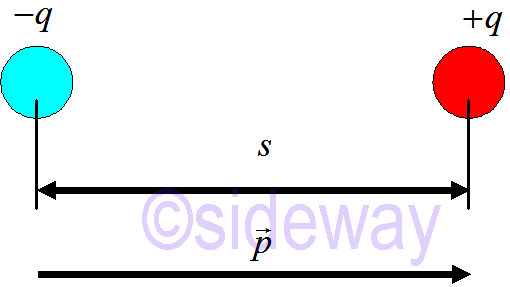Content
Electrical Force
Charged Particles
Electric Field of Spherical shell
Electric Dipole
Dipole Electric Field
Source and Reference
Electrical Force
The electrical forces of magnets and electricity are either induced of generated. These forces work very differently from general mechanic forces, e.g. gravitational forces. In fact, the attractive electrostatic force between two charged particles is far stronger than the gravitation forces being exerted between two solid particles.Charged Particles
The tiny particles prsent in atoms are called protons and electrons. Protons are positively charged, while electrons are negatively charged. Both protons and electrons are the smallest existing charged particles. Protons are very tightly packed within a nucleus of an atom. However, electrons can move freely around the nucleus since these electrons are not perpetually attracted to the nucleus. For example a hydrogen atom. The gravity of two masses is equal to
The gravity of two masses is equal to
𝐹grav=𝐺𝑚1𝑚2𝑟2
𝑟
𝑚proton=1.7×10−27𝑘𝑔 ; 𝑚electron=9×10−31𝑘𝑔
𝑟=5.3×10−11𝑚 ; 𝐺=6.7×10−11𝑁𝑚2𝑘𝑔2
𝐹grav=6.7×10−11(1.7×10−27)(9×10−31)5.3×10−11
≈𝑂(10−46)𝑁
Fhe electricity of two charged particles is
𝐹elec=14𝜋𝜀0
𝑄1𝑄2𝑟2
𝑟
𝑒=1.6×10−19𝐶
𝑟=5.3×10−11𝑚 ; 14𝜋𝜀0
=8.99×109𝑁𝑚2𝐶2
𝐹elec=8.99×109(1.6×10−19)25.3×10−11
≈𝑂(10−7)𝑁
Therefore with reference to an hydrogen atom, the electricity is much stronger than gravity. The ratio of two forces is
𝐹elec𝐹grav
≈2.27×1039Electric Field of Spherical shell
For a point particle, when the radius 𝑟 of electric field approaches 0, 𝐸 is undefined at the origin, since𝑟is self-contradictory. Therefore the particle cannot exert a force on itself.
For a uniformly charged spherical shell as below
 The charged spherical cell acts like a point particle for 𝑟≫𝑅, i.e.
The charged spherical cell acts like a point particle for 𝑟≫𝑅, i.e.
𝐸
𝑠𝑝ℎ𝑒𝑟𝑒=14𝜋𝜀0
𝑄𝑟2
𝑟
; for 𝑟>𝑅 i.e. outside the spherical shell𝑟direction even close up to the sphere. The total electric field
𝐸𝑠𝑝ℎ𝑒𝑟𝑒 can be calculated using the principle of superposition where
𝐸𝑡𝑜𝑡𝑎𝑙 is the vector sum of the electric field from all charges.
However, the electric field inside the shell is always equal to zero. i.e.
𝐸
𝑠𝑝ℎ𝑒𝑟𝑒=0; for 𝑟<𝑅 i.e. inside the spherical shellElectric Dipole
A electric dipole is a pair of two equal but opposite point charges at a distance apart. The dipole moment is
The dipole moment is
𝑝
=𝑞𝑠
Dipole Electric Field
By choicing the midpoint of the dipole as the origin, the dipole electric field can be determined as below The dipole electric field is equal to
The dipole electric field is equal to
𝐸
0,𝑥=𝐸
+,𝑥+𝐸
−,𝑥=14𝜋𝜀0
𝑞𝑟2+,𝑥
𝑟
+14𝜋𝜀0
−𝑞𝑟2−,𝑥
𝑟
𝐸0,𝑥=14𝜋𝜀0
𝑞(𝑟−𝑠/2)2
+14𝜋𝜀0
−𝑞(𝑟+𝑠/2)
along 𝑥-axis
𝐸0,𝑥=14𝜋𝜀0
𝑞𝑟2+𝑞𝑟𝑠+𝑞𝑠2/4−𝑞𝑟2+𝑞𝑟𝑠−𝑞𝑠2/4(𝑟−𝑠/2)2(𝑟+𝑠/2)2
𝐸0,𝑥=14𝜋𝜀0
2𝑞𝑟𝑠(𝑟−𝑠/2)2(𝑟+𝑠/2)2
𝑟−𝑠2
2≈𝑟+𝑠2
2≈𝑟2
𝐸0,𝑥=14𝜋𝜀0
2𝑞𝑠𝑟3
𝐸
0,𝑥=14𝜋𝜀02𝑞𝑠𝑟3,0,0
Source and Reference
https://www.youtube.com/watch?v=v57B_1ZBAho&list=PLZ6kagz8q0bvxaUKCe2RRvU_h7wtNNxxi&index=1
©sideway
ID: 191100302 Last Updated: 11/3/2019 Revision: 0
Latest Updated Links
- Philips CL400 Ceiling Light 36W(last updated On 11/2/2025)
- Philips CL400 Ceiling Light 24W(last updated On 11/1/2025)
- Philips CL400 Ceiling Light 13W(last updated On 10/30/2025)
- Ikea TISKEN basket(last updated On 10/29/2025)
- Ikea TISKEN towel rack(last updated On 10/28/2025)
- Ikea REXBEGONIA mattress protector(last updated On 10/27/2025)
- Ikea KEJSAROLVON mattress protector(last updated On 10/26/2025)
- Ikea KVARNVEN ergonomic pillow(last updated On 10/25/2025)
- Ikea BRUKSVARA pocket prung mattress(last updated On 10/24/2025)
- Ikea VÅGSTRANDA pocket sprung mattress super firm(last updated On 10/23/2025)
- Ikea VITVAL underbed(last updated On 10/22/2025)

 Nu Html Checker
Nu Html Checker  53
53  na
na  na
na
Home 5
Business
Management
HBR 3
Information
Recreation
Hobbies 8
Culture
Chinese 1097
English 339
Travel 18
Reference 79
Hardware 25![]()
Computer
Hardware 259
Software
Application 213
Digitization 37
Latex 52
Manim 205
KB 1
Numeric 19
Programming
Web 289
Unicode 504
HTML 66
CSS 65
SVG 46
ASP.NET 270
OS 431
DeskTop 7
Python 72
Knowledge
Mathematics
Formulas 8
Set 1
Logic 1
Algebra 84
Number Theory 206
Trigonometry 31
Geometry 34
Calculus 67
Engineering
Tables 8
Mechanical
Rigid Bodies
Statics 92
Dynamics 37
Fluid 5
Control
Acoustics 19
Natural Sciences
Matter 1
Electric 27
Biology 1
